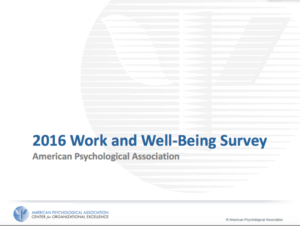Transparency is extremely important to us, so we are letting you know that we may receive a commission on some of links you click on from this page. See our disclaimer.

Dr. David Ballard, PsyD, MBA, director of APA’s Center for Organizational Excellence
It likely comes as no surprise to anyone running a successful workplace wellness program… but a new survey from the American Psychological Association shows that one of the most effective ways to drive employee engagement is through senior leaders getting involved themselves.
“Nearly three-fourths (73 percent) of employees with senior managers who show support through involvement and commitment to well-being initiatives said their organization helps employees develop a healthy lifestyle, compared with just 11 percent who work in an organization without that leadership support, according to APA's 2016 Work and Well-Being Survey. It was conducted online by Harris Poll among more than 1,500 U.S. adults in March.”
“The survey found widespread links between support from senior leaders and a variety of employee and organizational outcomes, with more than 9 in 10 workers saying they feel motivated to do their best (91 percent vs. 38 percent of those without leadership support), are satisfied with their job (91 percent vs. 30 percent) and have a positive relationship with supervisors (91 percent vs. 54 percent) and coworkers (93 percent vs. 72 percent). These employees are also more likely to recommend their company as a good place to work (89 percent vs. 17 percent) and fewer said they intend to leave their job in the next year (25 percent vs. 51 percent).”
Said David W. Ballard, PsyD, MBA, director of APA’s Center for Organizational Excellence: “Promoting employee well-being isn’t a singular activity, but is instead set up in a climate that is cultivated, embraced and supported by high-level leaders and managers. When supervisors’ actions match their words, employees notice.”
Indeed, focusing on employee wellbeing means more than just physical health.
 APA: “When it comes to building a climate of well-being, employers need to look beyond just physical health to help employees feel recognized, valued and involved and create opportunities for growth and development, Ballard said. But as the survey revealed, employers are falling short in their efforts.”
APA: “When it comes to building a climate of well-being, employers need to look beyond just physical health to help employees feel recognized, valued and involved and create opportunities for growth and development, Ballard said. But as the survey revealed, employers are falling short in their efforts.”
“Overall, only about half of employed adults said they feel valued by their employer (53 percent) and that the rewards and recognition they receive reflect the effort they put into their work (50 percent). Even fewer said the recognition they receive reflects their contributions to the organization (47 percent) and is based on a fair performance evaluation system (47 percent).
Just half of working Americans said they believe their employer provides enough opportunities to be involved in decision-making and fewer than that (46 percent) said they regularly participate in activities that involve them in making decisions, solving problems or setting goals.”
Ballard added: “Many employers say they focus on workplace wellness, but what is put into place is too often individual programs or policies that aren’t supported by the organization’s culture. Employers who truly embrace well-being as part of how they do business create a workplace where both employees and the organization thrive.”




0 Comments